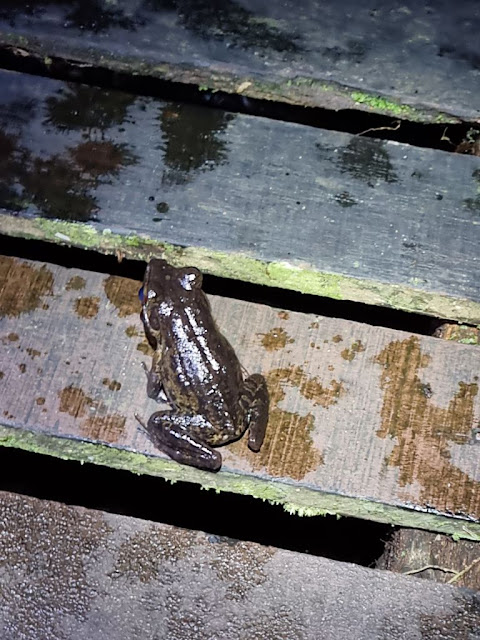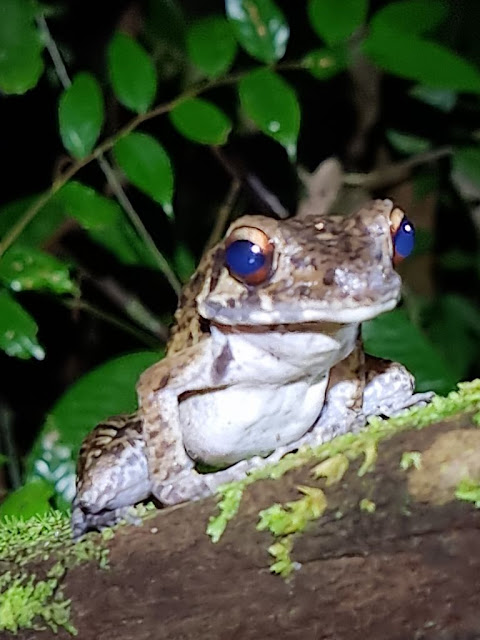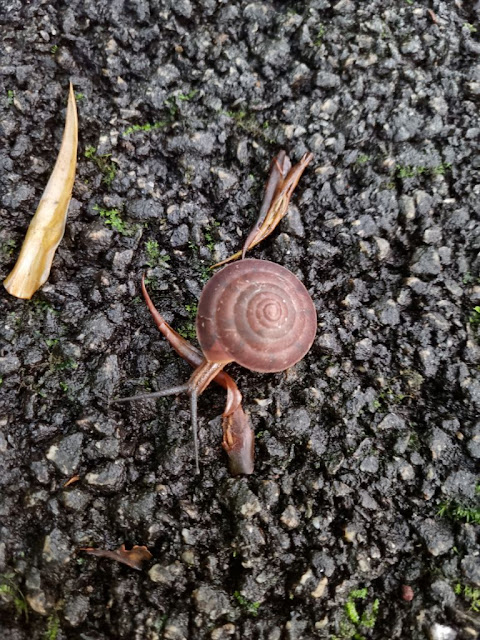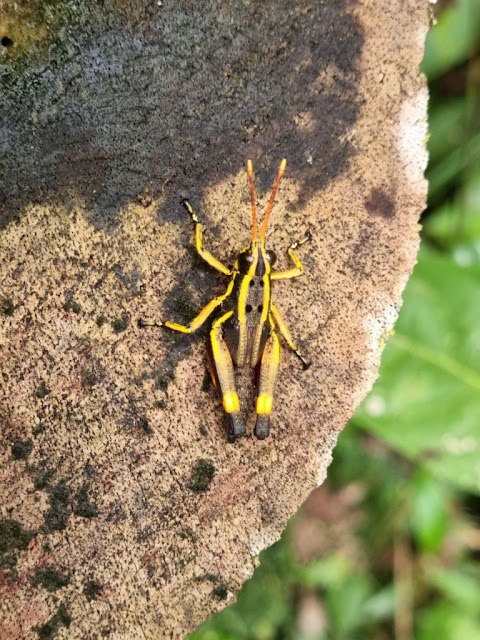Nachdem wir beide frühen Abende auf Fledermäuse gewartet haben, müssen wir jeweils wieder 3 Kilometer im Halbdunkel auf dem Holzsteg zu unserem Chalet zurücklaufen. Das dauert theoretisch etwa 45 Minuten, aber tatsächlich haben wir jedes Mal fast 1 1/2 Stunden für den Rückweg gebraucht. Der Grund: Wir stellen unsere Stirnlampen auf mittlere Stufe und versuchen, so viele kleine und nicht so kleine Dschungeltiere wie möglich zu finden. Es ist eine ganz schöne Herausforderung, Insekten, Reptilien und andere Krabbel- und Kleintiere zu entdecken, die oft sie gut getarnt sind und bei dichter Vegetation. Aber es macht so viel Spaß!!! Und wir sehen so viele seltsame, faszinierende, unerwartete Tiere - vielleicht auch dank unserer ersten nächtlichen Dschungelwanderung am Kinabatangan River, die uns gezeigt hat, wo und wie wir nach ihnen suchen müssen! 🤓
Neben der Genugtuung, für uns unbekannte Tiere zu finden oder solche, die wir nur von Zoobesuchen kennen, ist es auch ein besonderer Nervenkitzel, dem verrückten Konzert der Dschungelgeräusche zu lauschen, bei dem die lautesten "Spieler" Frösche sind. 😃 Nachfolgend eine Auswahl unserer schönsten Foto-Beuten und ein paar Videos, darunter eines vom Dschungelkonzert. Fragt uns nicht nach den genauen Tiernamen - wir haben keine Ahnung. 😂 😎
Unter uns haben wir zudem jede Nacht einen fiktiven Entdecker-Preis für denjenigen vergeben, der das spannendste oder seltsamste oder unerwartetste Tier entdeckt hat. In der ersten Nacht gewinnt Stef mit der Borneo-Riesenstabschrecke. In der zweiten Nacht gewinnt Anne den Award für den Frosch zwischen den weißen Pilzen. 🏆🏆
Das ist der letzte Post zu unserer Zeit in Mulu. Der Nationalpark hat uns wahnsinnig gut gefallen und wir würden auch ein zweites Mal hinreisen!!!
Dopo essere stati al punto di osservazione dei pipistrelli, dobbiamo camminare per 3 km nella semioscurità sulla passerella di legno fino al nostro chalet. In teoria ci vogliono circa 45 minuti, ma in realtà abbiamo impiegato ogni volta quasi un'ora e mezza per tornare. Perché? Con le lampade frontali accese a media potenza, la caccia è aperta: cerchiamo di trovare il maggior numero possibile di animali della giungla, piccoli e meno piccoli. È una bella sfida individuare insetti, rettili e altre bestiole striscianti e piccole creature, perché di solito sono ben mimetizzati e la vegetazione è fitta. Ma è molto divertente!!! E vediamo così tanti animali strani, affascinanti e inaspettati, forse anche grazie alla nostra prima passeggiata notturna nella giungla al Kinabatangan, che ci ha dato un'idea di dove e come cercarli! 🤓
Oltre alla soddisfazione di trovare animali a noi sconosciuti o che conosciamo solo grazie alle visite allo zoo, è anche un'emozione speciale ascoltare il folle concerto di suoni della giungla, dove i "suonatori" più rumorosi sono le rane 😃 Qui di seguito una selezione dei nostri più bei ritrovamenti fotografici e alcuni video, tra cui uno del concerto nella giungla. Non chiedeteci i nomi specifici degli animali: non ne abbiamo la minima idea. 😂 😎
Tra noi due abbiamo anche assegnato ogni sera un premio fittizio per l'individuazione dell'animale più emozionante, più strano o più inaspettato. La prima sera lo vince Ste con l'insetto stecco gigante del Borneo. La seconda sera Anne se lo aggiudica con la rana tra i funghi bianchi. 🏆🏆
Questo è l'ultimo post sul nostro soggiorno a Mulu. Il parco nazionale ci è piaciuto moltissimo e potremmo immaginare di tornarci anche una seconda volta!!!
After both times at the bats' observation point, we need to walk back 3km in the semi-darkness on the wooden walkway to our chalet. This takes in theory about 45 minutes, but realistically we spend each time nearly 1 1/2 hours getting back. Why? Having our headlamps turned on at mid-power, the hunt is on: we are trying to find as many small and not so small jungle animals as possible. It's quite a challenge to spot insects, reptiles and other creepy-crawlies and small critters, as they're usually quite well camouflaged and the vegetation is dense. But it's so much fun!!! And we see so many weird, fascinating, unexpected animals - maybe also thanks to our first nightly jungle walk at the Kinabatangan River, which gave us an idea of where and how to look for them! 🤓
Besides the satisfaction of finding to us unknown animals or those which we only know from visits to the zoo, it's also a special thrill to listen to the crazy concert of jungle sounds, where the loudest "players" are frogs 😃 Below a selection of our most beautiful photo bounties and a few videos, including one of the jungle concert. Don't ask us about the specific names of the animals - we don't have a clue. 😂 😎
Among the two of us we also assign each night a fictitious spotter award to the one who spots the most exciting or weird or most unexpected animal. On the first night, Stef wins it with the Borneo Giant Stick Insect. On the second night Anne claims it for the frog in between the white mushrooms. 🏆🏆
This is the last post about our time in Mulu. We really enjoyed the national park and would go there also once again!!!
.jpg) |
| Der bellende Frosch // La rana abbaiante // The barking frog |
 |
| Borneo Giant Stick Insect: Stefs Gewinner-Entdeckung // L'animale individuato da Ste e premio della prima notte // Stef's spotter award object |
 |
| Borneo Giant Stick Insect: Stefs Gewinner-Entdeckung // L'animale individuato da Ste e premio della prima notte // Stef's spotter award object |
 |
| White-lipped frog: Annes Gewinner-Entdeckung // L'animale individuato da Anne e premio della seconda notte // Anne's spotter award object |
 |
| White-lipped frog: Annes Gewinner-Entdeckung // L'animale individuato da Anne e premio della seconda notte // Anne's spotter award object |
.jpg) |
| White-lipped frog: Annes Gewinner-Entdeckung // L'animale individuato da Anne e premio della seconda notte // Anne's spotter award object |
 |
| Eine Larve hat sich ein Haus aus Stöckchen gebaut. // Una larva si è costruita una casa con dei bastoncini. // A larva has built itself a house out of sticks. |








.jpg)




























No comments:
Post a Comment